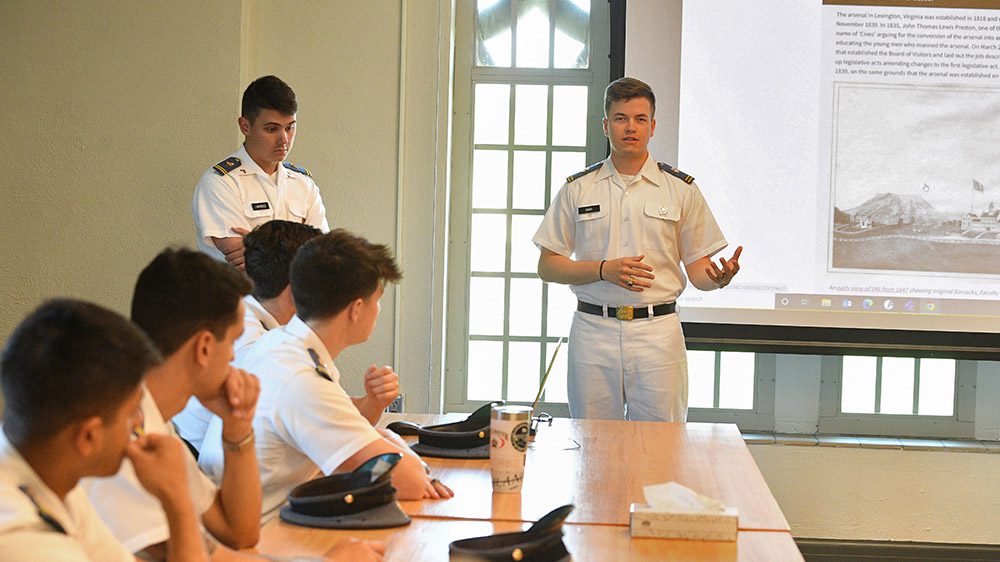Website Shares “Rewarding” Findings

Cadet Joshua Farr ’23 highlights the early years of VMI based on findings in archives May 3.—VMI Photo by Kelly Nye.

Cadet Joshua Farr ’23 highlights the early years of VMI based on findings in archives May 3.—VMI Photo by Kelly Nye.
This spring semester, Lt. Col. Pennie Ticen, Ph.D., associate professor of English, rhetoric, and humanistic studies, decided to team with Maj. Jeff Kozak, head of archives and records management, for Fieldwork, a compulsory class for all cadets majoring in English and part of the major core curriculum of the department. Fieldwork projects allow cadets to practice good citizenship by engaging in community-based service learning. Cadets’ fieldwork experiences may also involve projects for business, professional, or nonprofit organizations, usually taking place off post.
Ticen and Kozak offered their project, called “Cadet Life Over Time,” on post. It involved having the cadets delve into the wealth of VMI archives held at Preston Library, digitizing them, and building webpages. “From my first conversations with Major Kozak, I knew the archives had a wealth of physical materials that hadn’t yet been prepared for digital access. I have known and worked with him since he was an archivist for the Marshall Museum library, and I was confident he would be a strong partner for this project,” said Ticen.
Working in pairs, 12 cadets covered six eras:
Lawrence, who researched the early years, said he had talked last semester with Ticen about what the class would encompass, and he looked forward to it. He was intrigued with the progression of how the state arsenal became VMI. “The cadets back then had a harder course load than we do, and because travel was slow back then, many of the cadets stayed here year-round,” stated Lawrence.
Ripley, a double major in history and English, acknowledged, “I enjoyed the class because it gave me hands-on experience in archival research. In researching the Great Depression era, I discovered that the Depression only mildly affected VMI, which in turn was able to support many in the Lexington area on which the Depression had a greater impact.”
Wiemann, an English major who covered World War I, confessed, “I did not expect this class to be fun or exciting, but after the first two meetings, I found myself thoroughly enjoying and looking forward to the class. While my partner and I were both interested in our research topic of World War I, the process of searching through a physical archive collection for information was a new experience for us. I was surprised with the vast amount of information available in the archives.”
Wiemann continued, “As a commissioning cadet, I found Thomas Amory’s story to be especially inspiring. Amory died while selflessly putting the lives of his men before that of his own. As a future officer of Marines, I hope to follow Amory’s example by putting others before myself.”
Wiemann’s partner, Tempesta, agreed with Wiemann regarding the expanse of archived information. “We started with a handful of files and were able to build a detailed profile on Thomas Amory,” said Tempesta.
Kozak felt the results of the class were rewarding. “It is wonderful to be able to publicly display the cadets’ work on the VMI website, where it can serve as an inspiration to other cadets and the public to learn more about VMI’s history. The biggest surprise for me was the variety of records that the cadets used from the archives during their research. I thought they might stick to one kind of record, but they did not hesitate to use many different types of records, including correspondence, annual reports, yearbooks, regulations, blueprints, newspapers, diaries, and photographs,” said Kozak.
The cadets’ research web pages may be viewed here.